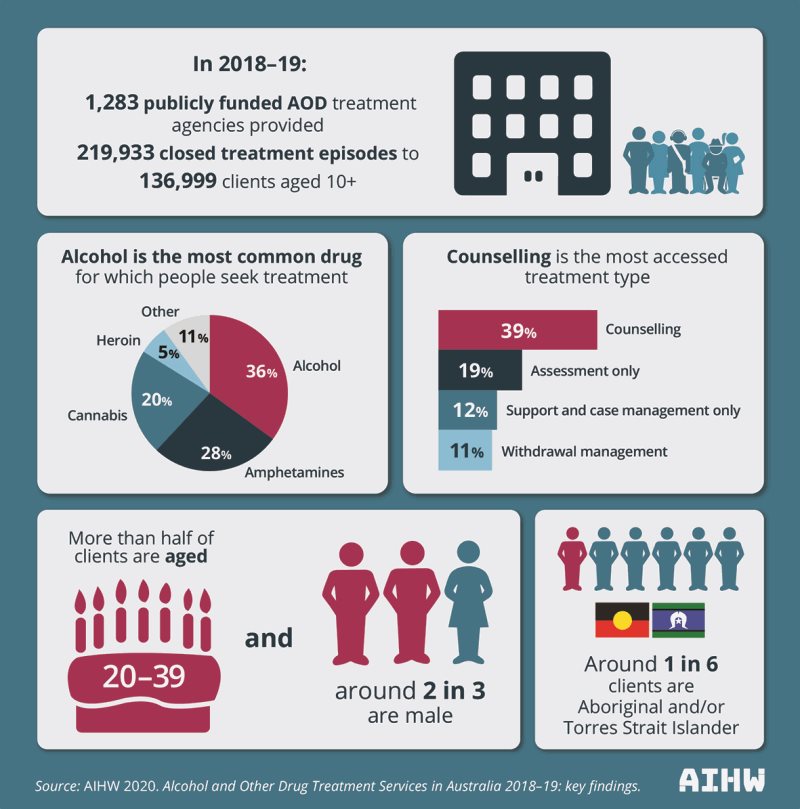Summary
Alcohol and other drug (AOD) treatment services across Australia provide a broad range of treatment services and support to people who use alcohol or drugs, and to their families and friends. This report presents information for 2018–19 about publicly funded AOD treatment service agencies, the people they treat and the treatment provided.
Around 137,000 clients sought AOD treatment in 2018–19
In 2018–19:
- around 137,000 clients aged 10 and over (a rate of 623 clients per 100,000 people) received treatment, a 19% rise since 2014–15 (115,000 clients)
- around two-thirds of clients were male (64%), and over half of clients were aged 20–39 (54%)
- 1 in 6 (17%) clients aged 10 and over identified as Indigenous Australian, representing a rate of 3,580 clients per 100,000 people, compared with 515 clients per 100,000 for non‑Indigenous Australians
- treatment agencies provided about 220,000 closed treatment episodes – an average of 1.6 episodes per client
- around 4 in 5 (79%) episodes ended within 3 months
- less than 1% (3,169) of clients received treatment in every collection year from 2014–15.
Over two thirds of all treatment episodes within the amphetamines group were for methamphetamines only
Alcohol, cannabis, amphetamines and heroin have remained the most common principal drugs of concern for clients since the beginning of the collection.
In 2018–19, among clients seeking treatment for their own alcohol or drug use:
- alcohol was the most common principal drug of concern (36% of episodes), followed by amphetamines (28%), cannabis (20%), and heroin (5%)
- around two thirds (66%) of treatment episodes within the amphetamines group were for methamphetamines as a principal drug of concern
- alcohol was the most common principal drug of concern for clients aged 40 and over (56%), while cannabis was the most common for clients aged 10–19 (58%)
- most clients with heroin as a principal drug of concern were aged 30–49.
Treatment episodes for amphetamines increased nearly 6-fold over 10 years
Over the 10-year period to 2018–19:
- the number of treatment episodes for amphetamines increased nearly 6-fold from 10,000 episodes to 58,200 episodes nationally
-
where amphetamines were the principal drug of concern, the number of episodes where the method of use was smoking, inhaling, or injecting increased over 6-fold, from around 8,000 episodes in 2009–10 to 52,200 episodes in 2018–19
- almost two thirds (38,470 episodes) of all treatment episodes within the amphetamines group were for methamphetamines only in 2018–19, increasing from 12% (1,243 episodes) in 2009–10
- the proportion of episodes where alcohol was the most common principal drug of concern decreased from 48% in 2009–10 to 36%
- the number of heroin treatment episodes fell from around 13,900 to 10,900 treatment episodes.
Counselling continues to be the most common type of treatment
Since 2009–10 the proportion of episodes for each of the four most common main treatment types have fluctuated.
- Counselling has continued to be the most common treatment type (39% of episodes in 2018–19).
- There have been increases in the proportion of episodes for both support and case management only (from 9% in 2009–10 to 12% in 2018–19) and assessment only (14% to 19%).
- There has been a decline in the proportion of treatment episodes with withdrawal management (from 17% in 2009–10 to 11% in 2018–19) and counselling (42% to 39%) as the main treatment type.

-
Summary
1. Introduction
- Drug use in Australia
- National Drug Strategy
- Alcohol and other drug treatment services
- The AODTS NMDS
- Accompanying material
2. Agencies
- Number of agencies
- Service sector
- Remoteness area
3. Clients
- Characteristics of clients
- Clients and drugs of concern
- Client service use over multiple years
4. Drugs of concern
- Drugs of concern and treatment provided
- Alcohol
- Cannabis
- Amphetamines
- Heroin
- Pharmaceuticals
- Selected other drugs
5. Treatment provided
- Referral to treatment
- Duration of treatment
- Treatment completion
- Treatment types
Appendix A: Data and methods
End matter: Acknowledgments; Abbreviations; Symbols; Glossary; References; List of tables; List of figures; List of boxes



